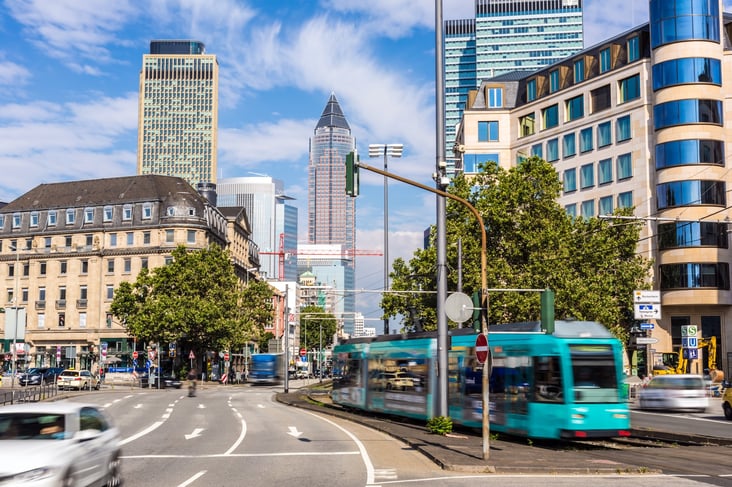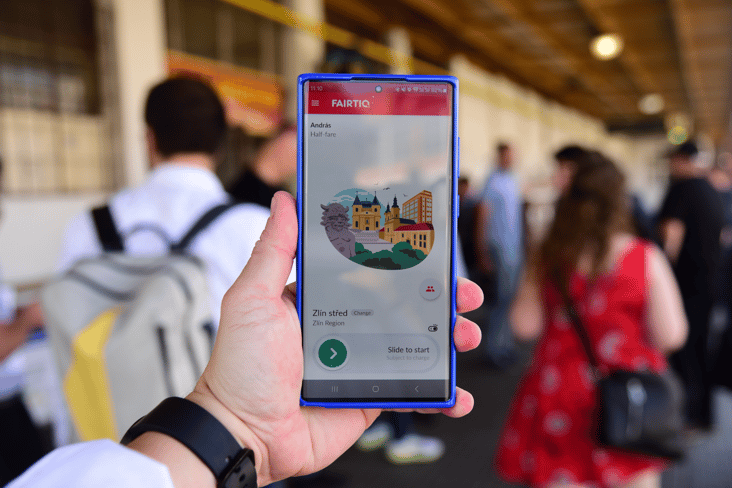
In this interview we talk to Antoine Belaieff (left side above), Lead North America at FAIRTIQ and Jonas Lutz (right side above), Head of Product & Marketing at FAIRTIQ about FAIRTIQs part take at the SwissCal Conference, why Americans are interested in the Swiss transportation universe, what the key differences between the systems are and much more.
The SwissCal conference was organised by the Seamless Bay Area in San Francisco
The Seamless Bay Area is a not-for-profit organization based in San Francisco aims to build a diverse movement for change and promote policy reform to transform the Bay Area’s fragmented public transit into a world-class, unified, equitable, and widely-used system.
The conference focused on expanding understanding on best practices from Switzerland’s highly effective public transportation ecosystem and identifying steps to apply them in California. There were approximately 100 participants from across California, representing transit agencies, state agencies, non-profit groups, and elected officials.
The following links sum up each day of the SwissCal conference in detail:
- Blog 1: “One journey, one ticket”
- Blog 2: A Seamless Customer Experience and a Cooperation Based Model of Public Transport
- Blog 3: Technology, Emerging Mobility, and Applying Swiss Practices in California
The FAIRTIQ solution has both benefited from the seamless nature of the Swiss transport ecosystem, and contributed to shape it. Switzerland and the FAIRTIQ solution provide inspiration for other regions around the world to make public transport more user friendly, and get more people to ‘hop on the train’ of sustainable mobility.
In the following Antoine and Jonas share their insights and what they took from the three day long conference and what FAIRTIQ brought to the table during the event.
How did the idea of a conference series on the Swiss transport ecosystem evolve in the first place?
Antoine Belaieff:
I knew that both my home region of Toronto and the Bay Area were thinking about how to best organize public transportation to create a more seamless experience, and I felt that Switzerland - although it is quite unique - could provide some inspiration to guide discussions. I happened to know Ian Griffiths, the co-founder of Seamless Bay Area, and we both thought that it would be a great project to work on together.
What was the intention and the aim behind that conference series?
Antoine Belaieff:
We wanted to show how the Swiss public transportation system is structured and organized with an interesting balance of central coordination and local autonomy, with specific roles played by governments, public agencies, associations and private providers. We felt that this could be of interest to anyone who is interested in making their region more seamless, with public transportation that works better to meet residents’ needs.
Were your expectations fulfilled or maybe even surpassed?
Antoine Belaieff:
I was surprised by the amount of interest not just in the Bay Area but also in the Los Angeles Area. We had professionals at all levels and even elected officials attend the conference and the subsequent workshops. They took in a lot of information and quickly pivoted to discuss how it be applied at home.
Why is the Swiss public transport system a best practice example for other areas in the world?
Antoine Belaieff:
Of course Switzerland is a small, dense and wealthy country. But it has managed to really leverage its assets to provide an extraordinary public transportation system. Even the smallest village is served, even in mountainous areas. Schedules are synchronized nationwide, and standards are kept high through regulation, cooperation and constant attention to quality. And of course you can pay with FAIRTIQ from any point to any point in the country without knowing who operates the service or what kind of ticket to buy. As a planner who lives outside of the country, I also admire a recent push to promote “transit oriented development. You see tall buildings pop up near many stations, both residential and commercial.
What are key differences between the Californian model of public transport and the Swiss one and what can they learn from one another?
Antoine Belaieff:
They are of course difficult to compare, but California is now very determined to make its public transportation system more integrated and seamless to make it more effective. Those who want California to bolster the role of public transportation may want to look not just at how Switzerland achieved seamlessness, but also at how Switzerland managed to progressively increase its spending over the years. Swiss taxpayers are also watchful of spending, and just like Californians have a big toolbox to influence spending at the ballot box.
And discussions about accessibility and equity tend to be more open in the United States. Inequalities also exist in Switzerland, and could be addressed faster if discussions were more centrestage, including in public transportation.
How does FAIRTIQ rethink ticketing and why is a ticket revolution needed?
Jonas Lutz:
Public transport users don’t care about public transport. People want to go safely from A to B - their aim is to get to B and pay a fair price for their trip. Buying a ticket is a hurdle to using public transport. FAIRTIQ knows from recurring survey that the ease of use of its solutions attracts up to 30% new users, who were previously not using or very seldomly.
FAIRTIQ believes that charging for mobility and not a ticket is key. This is one of the reason why tickets are not shown in the FAIRTIQ to the user, but just the journey and its price.
What makes the FAIRTIQ solution special?
Jonas Lutz:
FAIRTIQ manages to be both super-simple - just check in and check out - and really sophisticated in the background. Agencies can implement all kinds of fares and rewards to attract new riders and them to ride more frequently, and get data they never had before. FAIRTIQ is a service, so it doesn’t need years of design and development. It can also function without any hardware.
What does user-centricity mean in the FAIRTIQ world?
Jonas Lutz:
For FAIRTIQ, user-centricity means having the user at the heart of our decision making process. What does the user want? How can we help the user? How can we simplify her life even further?
How can public authorities and private businesses such as FAIRTIQ work hand in hand to reform public transport?
Jonas Lutz:
From our six years of experience, we see that as a startup we can consistently take the users’ point of view and bring new ideas to operators and authorities. We also see that operators and authorities benefit when we bring innovation to new regions and be a messenger from one region to the next. The SwissCal conference is a perfect illustration for this.
FAIRTIQ is so far mainly used in non-gated public transport systems. How would the FAIRTIQ solution cope with gates?
Jonas Lutz:
That is correct, but depending on the age and design of the infrastructure in place, FAIRTIQ can work with gates and validators.
Is the FAIRTIQ solution accessible also for people without smartphones?
Jonas Lutz:
The solution does require a smartphone, and we know of course that not everyone has one. Our clients always provide alternatives, which need to be specifically designed for the needs of each community. FAIRTIQ is a good complement to old-school fareboxes to accept cash on board or vending machines. Of course agencies can issue reloadable cards and install validators on every vehicle, but we feel that this is increasingly an expensive and complicated approach to fare collection.
How fast can FAIRTIQ be implemented in any public transport system throughout the world? What are challenges and obstacles and what are the experiences so far?
Jonas Lutz:
We believe that our system can be implemented more or less anywhere. We have discussions with potential partners around the world. The speed at which we are able to implement our solution in new geographies depends on our ability to convince that we can help solve operators’ and agencies’ challenges as well as our ability to have our solution evolve to meet new challenges. Bus and train passengers in over 40 transport areas can enjoy contactless travel courtesy of the FAIRTIQ app, not only in their home region but also in all other participating regions. FAIRTIQ has built up an impressive partner network of public transport providers and associations in Switzerland, Germany, Austria and Liechtenstein. FAIRTIQ technology also powers Easy Ride, the Swiss Federal Railways (SBB) app. Austrian Federal Railways (ÖBB) is also set to adopt FAIRTIQ technology, and pilot projects are already under way in Belgium and France.
Thank you both for the interview!
Contact us now to find out what FAIRTIQ can do for you:









Share